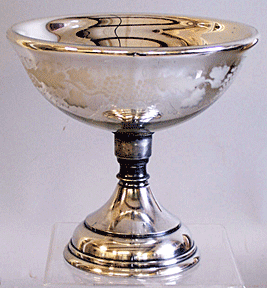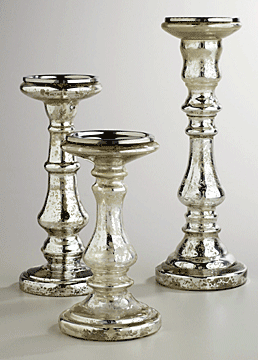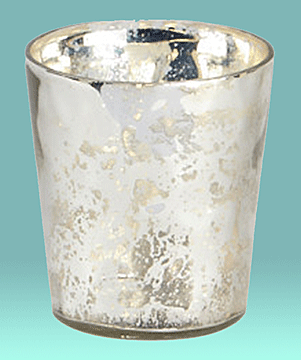All That Glitters Isn’t
Silver
by Bob Brooke
 As
the Industrial Revolution gained momentum, the growing middle class
wanted inexpensive alternatives to the silver objects owned by the
wealthy. One of those alternatives was Mercury glass, first made as an
inexpensive silver substitute. Soon it evolved into an art form of its
own. As
the Industrial Revolution gained momentum, the growing middle class
wanted inexpensive alternatives to the silver objects owned by the
wealthy. One of those alternatives was Mercury glass, first made as an
inexpensive silver substitute. Soon it evolved into an art form of its
own.
First produced in the late 18th century, Mercury glass is handblown,
double wall glass with an interior coating of silver-colored metal
compounds. It took many forms, including candlesticks, compotes, candy
dishes, plates, goblets, wig stands, curtain tiebacks, and doorknobs.
Some critics condemned it for looking too much like mirrored glass and
too little like silver, which is what people liked about it.
Produced originally from around 1840 until around 1930 in Bohemia, now
the Czech Republic, and Germany, it spread to England in 1849 when
Edward Varnish and Frederick Hale Thomson patented the technique for
silvering glass vessels, and continued to be made there until 1855.
 Mercury
glass, also known as silvered glass, contains neither mercury nor
silver. It's actually clear glass, mold-blown into double-walled shapes
and coated on the inside with a silvering solution containing silver
nitrate and grape sugar, heated, then closed. Sealing methods included
metal discs covered with a glass round in England, or a cork inserted
into the unpolished pontil scar on the bottom in America. In the
beginning a few Bohemian makers tried to line their pieces with a
mercury solution, but they stopped using it due to expense and toxicity.
However, this is where the name originated. Mercury
glass, also known as silvered glass, contains neither mercury nor
silver. It's actually clear glass, mold-blown into double-walled shapes
and coated on the inside with a silvering solution containing silver
nitrate and grape sugar, heated, then closed. Sealing methods included
metal discs covered with a glass round in England, or a cork inserted
into the unpolished pontil scar on the bottom in America. In the
beginning a few Bohemian makers tried to line their pieces with a
mercury solution, but they stopped using it due to expense and toxicity.
However, this is where the name originated.
Companies in the United States, including the Boston and Sandwich Glass
Company, New England Glass Company Union Glass Co., and the Boston
Silver Glass Company, made silvered glass from about 1852 to 1880. The
New England Glass Company displayed a variety of silvered glass
articles, including copper wheel engraved goblets, vases and other
tableware at the 1853 New Crystal Palace Exhibition.
 Bohemian
Mercury glassmakers decorated their pieces with a variety of techniques
including painting, enameling, etching, and surface engraving. Antique
historians believe it to be the first true "art glass"----glass made for
display and for its artistic value rather than for everyday use. Bohemian
Mercury glassmakers decorated their pieces with a variety of techniques
including painting, enameling, etching, and surface engraving. Antique
historians believe it to be the first true "art glass"----glass made for
display and for its artistic value rather than for everyday use.
The peak of Mercury glass’ popularity came in the mid-19th century. Back
then, high-quality European and American-made pieces where lightweight,
had graceful forms, and came decorated with acid-etched fruit or floral
motifs, cut glass designs, and sometimes paint. Young girls, working on
assembly lines, painted vases in particular with their own designs of
swans, daisies, or leaves. Makers intended the details on their pieces
to be equal to the finest decoration on other forms of glass and china.
After briefly falling out of favor, Mercury glass reappeared around 1900
in the form of Christmas ornaments and gazing balls, as well as blown
fruits and flowers. Today, most serious collectors concentrate on
antique forms, like curtain pins, salt cellars, or pedestal-footed
silvered vases.
<
Back
to More Antique Spotlights
Next Article >
|
